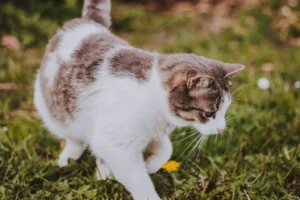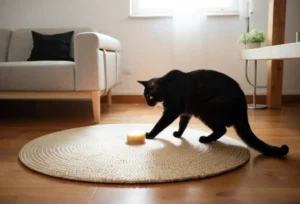Cats can be loving and affectionate pets, but sometimes they can show aggression towards other cats. Have you ever wondered why cats exhibit aggressive behavior towards their feline counterparts? Let’s explore the reasons behind this common phenomenon.
Instinctual Behavior
Cats are known for their independent and territorial nature, which can lead to aggression towards other felines. This behavior stems from their instinctual need to establish and defend their territory. In the wild, cats must protect their resources, such as food, shelter, and potential mates, to ensure their survival. This primal urge is still present in domestic cats today, causing them to react aggressively when they feel their territory is being invaded.
Additionally, cats are natural predators, and their instinct to hunt and defend their prey can also contribute to aggressive behavior towards other cats. This predatory instinct can be triggered when a cat perceives another feline as a potential threat to their territory or resources.
Understanding and recognizing these instinctual behaviors can help cat owners better manage their pets’ interactions and minimize potential aggression. Providing separate resources, such as food and water bowls, litter boxes, and resting areas, can help reduce competition and conflicts among cats in the same household.
Competition for Resources
Competition for resources is a common trigger for aggression between cats. When multiple felines share the same living space, they may feel the need to compete for essential resources like food, water, and territory. This competition can escalate into aggressive encounters as cats attempt to assert dominance and secure their access to these resources.
To prevent conflict over resources, it’s crucial for cat owners to provide an adequate number of resources to accommodate all their pets. Having multiple feeding stations, water bowls, and litter boxes can help alleviate competition and reduce the likelihood of aggressive behavior. Creating a harmonious environment with plenty of resources for each cat can promote peaceful coexistence and minimize conflicts.
In addition to physical resources, cats also value personal space and territory. Ensuring that each cat has their own designated areas to eat, sleep, and play can help prevent territorial disputes and reduce the incidence of aggression. By promoting a sense of security and autonomy for each feline, cat owners can create a more peaceful and harmonious multi-cat household.
- Tip: Providing vertical space, such as cat trees and shelves, can also help cats establish their territory and escape conflicts on the ground. Vertical space allows cats to survey their surroundings, seek privacy, and assert their dominance without direct confrontation. Consider incorporating vertical elements into your home to create a cat-friendly environment that promotes harmonious interactions among feline companions.
Lack of Socialization
Cats, just like humans, need socialization to learn proper behavior. A lack of early socialization can lead to aggression towards other cats. If a kitten wasn’t exposed to other cats or animals during the critical socialization period (which is usually up to 3 months of age), they may not know how to interact appropriately with other felines. This can result in aggressive behaviors when they encounter other cats later in life. To help prevent this, make sure to expose your kitten to various experiences, including interactions with other cats, in a safe and controlled environment.
Additional Insight: One way to help socialize your cat is through supervised playdates with other friendly cats. This can help them learn proper social cues and reduce the likelihood of aggressive behavior towards other felines.
Stress and Anxiety
Stress and anxiety can play a significant role in causing aggression towards other cats. Cats are sensitive creatures, and changes in their environment or routine can trigger feelings of stress and anxiety. This can manifest as aggression towards other cats as a way for them to cope with their emotions. Factors like a new pet in the household, moving to a new home, or even loud noises can contribute to a cat feeling stressed and acting out aggressively towards other felines. To help reduce stress and anxiety in your cat, provide them with a safe and comfortable environment, regular routines, and plenty of mental stimulation through play and interactive toys.
Remember, a stressed cat may lash out at other cats as a way to cope. It’s essential to address the underlying stressors to prevent aggression towards their feline companions.
Medical Issues
Cats, just like humans, can become aggressive due to underlying medical issues. Pain or illness might be causing your feline friend to act out towards other cats. Imagine if you were in pain – you’d likely be irritable too! Therefore, it’s crucial to rule out any medical causes for your cat’s aggression. A visit to the vet can help identify any physical problems that could be contributing to their behavior. Once the medical issues are addressed, you may see a significant improvement in your cat’s interactions with other felines.
Introduction of New Cats
Introducing a new cat into your household can be a tricky situation. Cats are territorial creatures, and bringing in a new member can lead to aggression as they establish boundaries. To smooth the transition and minimize conflict between cats, start by providing separate living spaces for the new cat and resident cat. Slowly introduce them by swapping their scents on blankets or using a gradual feeding schedule. Monitor their interactions closely and be patient – it may take time for them to adjust to each other’s presence.
Tips for Introducing New Cats:
- Gradual Introductions: Allow the cats to sniff each other under the door before face-to-face interactions.
- Positive Reinforcement: Reward good behavior with treats or toys to create positive associations.
- Safe Spaces: Ensure each cat has their own hiding spots and vertical spaces to feel secure.
- Supervised Meetings: Supervise interactions between cats to prevent aggressive behavior.
- Patience: Remember, patience is key during the introduction process. Cats need time to establish a relationship on their terms.
By following these tips and being observant of your cats’ behavior, you can help facilitate a peaceful coexistence between your furry companions.
Behavioral Modification
Cats can exhibit aggression towards other cats due to territorial instincts, fear, or social hierarchy issues. To modify this behavior, consider positive reinforcement techniques like clicker training to reward desirable actions. Environmental enrichment, such as providing ample vertical space, hiding spots, and interactive toys, can help reduce stress and redirect aggressive energies. Seeking guidance from a professional behaviorist can also offer tailored strategies and solutions to address specific aggression triggers in your feline companions.
Creating a Peaceful Environment
To foster a harmonious living environment for multiple cats, ensure each cat has access to their own resources like food, water, litter boxes, and resting areas. Providing separate feeding stations and litter boxes can reduce competition and potential conflicts. Utilize vertical spaces like cat trees and shelves to create escape routes and territory markers. Regular play sessions and interactive toys can channel excess energy and promote positive interactions. Additionally, consider pheromone diffusers or calming supplements to help alleviate tension among feline housemates.
Tips for Creating a Peaceful Environment:
- Designate Individual Spaces: Each cat should have their own designated feeding, resting, and elimination areas to avoid territorial disputes.
- Vertical Territory: Install cat trees, shelves, and perches to offer vertical space for cats to establish hierarchy and retreat when needed.
- Interactive Playtime: Engage your cats in daily play sessions with interactive toys to promote exercise, mental stimulation, and social bonding.
- Calming Aids: Incorporate pheromone diffusers or calming supplements to help reduce stress and anxiety levels in multi-cat households.
- Routine Veterinary Check-ups: Regular veterinary visits can ensure your cats are healthy, identify potential medical issues, and address any underlying health concerns affecting behavior.
Fun Fact:
Did you know that cats have scent glands on their cheeks, paws, and tail that they use to mark their territory and communicate with other cats?
When it comes to understanding why cats can be aggressive towards other cats, it often boils down to territorial behavior. Cats are naturally territorial animals, and when they feel their territory is being invaded by another cat, they may become aggressive in an attempt to defend it. This behavior is rooted in their instincts to protect their resources, such as food, water, and a safe space to rest.
One key factor that can trigger aggression between cats is the lack of proper introduction. When bringing a new cat into the home, it is crucial to introduce them gradually, allowing the resident cat to adjust to the newcomer’s presence. Failure to do so can lead to territorial disputes and conflict between the cats.
Additionally, cats can display aggression towards other cats due to factors such as fear, stress, or competition for resources. It’s essential to ensure that each cat in the household has their own food, water, litter box, and resting areas to prevent conflicts over these vital resources.
To promote harmony among your feline friends, provide plenty of vertical space for cats to perch and escape potential conflicts, such as tall cat trees or shelves. Creating separate feeding stations and litter boxes for each cat can also help reduce competition and prevent aggression.
Remember, cats are individuals with unique personalities, and some may be more prone to aggression towards other cats than others. By observing your cats’ behavior and providing a safe and enriched environment, you can help minimize conflicts and foster a peaceful coexistence among your feline companions.
Additional Insight:
Applying pheromone diffusers or sprays, such as Feliway, can help reduce stress and promote a sense of calm in multi-cat households. These products mimic natural feline pheromones and can aid in calming anxious or aggressive cats, potentially reducing conflicts between them.
Alex, a passionate animal lover, has experience in training and understanding animal behavior. As a proud pet parent to two dogs and three cats, he founded AnimalReport.net to share insights from animal experts and expand his knowledge of the animal kingdom.




